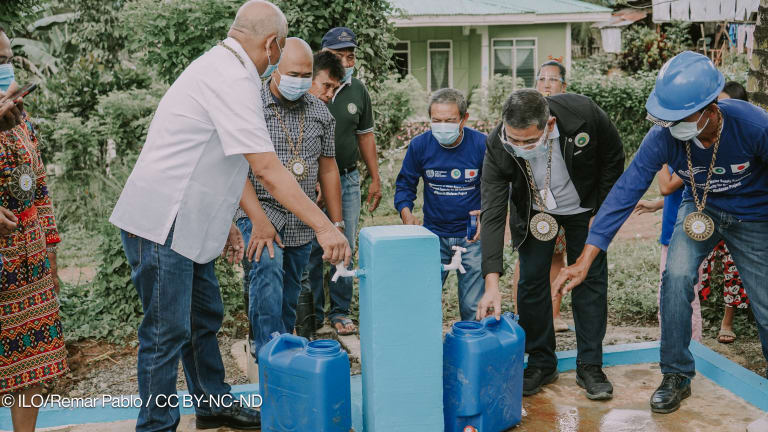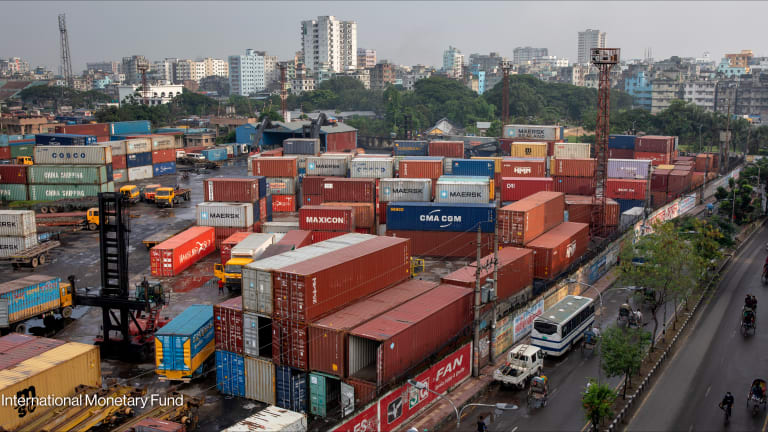
Have you ever wondered which countries rely on official development assistance the most? Well we did, so the Devex team began crunching some numbers to determine the top 10 countries in the world in terms of the percentage of their total gross national income represented by foreign aid (see chart).
As you might have guessed, the majority of the top 10 are geographically or economically isolated countries with small populations, but also very impoverished. Four out of the 10 countries are fragile states located in sub-Saharan Africa, five are small island nations prone to natural disasters, and one is the poorest country in the Western Hemisphere still reeling from a devastating earthquake.
Australia, the United States, and United Kingdom are the largest bilateral donors to these 10 countries. The European Union also emerged as a major donor, especially to the sub-Saharan Africa countries on the list. Unsurprisingly, donations to these countries are largely focused on development building blocks such as post-conflict reconstruction and infrastructure development as well as basic health and education services. Here’s our list and explanations:
Liberia
The election of Ellen Johnson Sirleaf, Africa’s first elected female leader, in 2005 ushered in a period of hope for this West African country that remains damaged from the effects of a 14-year civil war. In 2010, Johnson Sirleaf declared that “Liberia should not need aid in 10 years,” but most agree that the country has a long way to go before weaning itself off of foreign assistance. In 2010, Liberia received $1.42 billion in ODA while posting a gross national income of $805 million. The United States is Liberia’s largest bilateral donor, providing $450 million in aid to support democratization, security sector reform, female education, and reconstruction efforts.
Solomon Islands
Ethnic tensions from 1998 to 2003 caused the economy of the Solomon Islands to contract, plunging countless people into poverty. There have been significant socio-economic improvements since then but foreign aid remains the island nation’s major source of funding. In 2010, approximately $340 million of the Pacific island country’s $555 million GNI was ODA with much of this money coming from the country’s most important donor: Australia. In 2009, Prime Ministers Kevin Rudd and Derek Sikua signed the Australia-Solomon Islands Partnership for Development to reduce poverty and take steps toward achieving the Millennium Development Goals by 2015. Australia committed a total of 261 million Australian dollars ($280.99 million) to the Solomon Islands for fiscal 2011-2012.
Marshall Islands
A low population, tiny land mass, lack of skilled labor and untapped ecological resources (among other factors) makes the Marshall Islands especially vulnerable to economic shocks, diseases and natural disasters. Of the country’s $186 million GNI, about $91 million was represented by ODA. The island nation is one of three associated states of the United States, which makes it a sovereign minor partner that has access to many U.S. domestic programs including disaster response/recovery and hazard mitigation. Naturally, the United States is the country’s largest bilateral donor giving about $58 million annually under the Compact of Free Association which defines the relationship between the United States and its three sovereign but associated states. Australia has allotted an estimated AU$3.5 million to the Marshalls for fiscal 2011-2012.
Haiti
Haiti has been struggling economically for years and the devastating earthquake in January 2010 that took the lives of some 200,000 Haitians further hindered the country’s prospects for economic recovery. Of Haiti’s GNI of $6.73 billion in 2010, $3.07 billion was official development assistance. On March 31, 2010 at the international donors’ conference in New York, 58 donors pledged funds to support Haiti’s recovery and development after the disaster. As of December 2011, a total of $5.5 billion was pledged to the fund with Venezuela giving the highest donation estimated at $1.3 billion followed by the United States at $1.1 billion. Some 19 donors pledged a total of $579 million to the Haiti Reconstruction Fund, which aims to finance post-quake reconstruction.
Federated States of Micronesia
Micronesia is in free-association with the United States (along with the Marshall Islands and the Republic of Palau) and receives substantial aid from America. The country receives some $58 million in grants annually from the United States under the Compact of Free Association. Some of the development challenges facing the country are its remote location, which inhibits the growth of its tourism industry and results in high transportation and communications costs, lack of skilled labor and a fragile natural environment. The U.S. compact funds the delivery of basic education and health services, as well as infrastructure improvements and private and public sector capacity building. Another hindrance to growth is its perceived overdependence on U.S. aid. In 2010, $125 million out of the country’s gross national income of $309 million was ODA.
Burundi
Burundi is another fragile state recovering from the devastation of a 12-year civil war. The peaceful election of its first democratic government in 2005 and again in 2010 paved the way for donor confidence and stability. The country remains poor, however, and heavily dependent on aid. Belgium is its largest bilateral donor, focusing its efforts on the agricultural, health and education sectors. Belgium’s annual aid budget for Burundi is around €40 million ($52.66 million). In 2009, Belgian Development Cooperation allotted €149 million for the period 2010-2013 to cover cross-cutting issues such as gender equality and sustainable development among others. The United States, European Union and World Bank are also major donors to the East African country. In 2010, Burundi received $632 million in ODA, which is 39.8 percent of its GNI of $1.58 billion.
Tuvalu
An extremely remote country vulnerable to the impacts of climate change, Tuvalu is heavily reliant on foreign funding. The Tuvalu Trust Fund is one of the major sources of revenue for Tuvalu. The Fund, incorporated under the International Organizations (Privileges and Immunities) Act of 1964, is being overseen by the Tuvalu government and fund managers in Australia. The International Trust Fund Agreement was signed in 1987 by the government, Australia, New Zealand and the United Kingdom. Apart from Australia, which committed a total of AU$9.9 million to Tuvalu for fiscal 2011-2012, New Zealand and Japan are major bilateral donors to the country. In 2010, Tuvalu’s GNI was $38 million, $13 million of which was ODA.
Democratic Republic of Congo
This fragile state in Central Africa continues to struggle with instability and conflict. It is slowly recovering from a devastating civil war and grappling with enormous development challenges including inadequate infrastructure and working social institutions. Most donors are focusing on health and education, as well as peace building and governance. The United States provided $306 million in assistance to DRC in 2010 while the United Kingdom plans to nearly double its bilateral aid to the country within from 2011 to 2015. Barring any unforeseen circumstances, the United Kingdom will increase its current annual aid to DRC from 147 million pounds ($231.36 million) in 2011 to 258 million pounds by 2015. This would make the United Kingdom the largest bilateral donor to the country.
Samoa
Samoa is still feeling the effects of the 2009 tsunami that hit the small island nation and caused major damage to infrastructure and social services. Australia is Samoa’s largest bilateral donor and is assisting the country in reconstruction and recovery efforts. Other major donors such as the World Bank, Asian Development Bank, European Union and New Zealand also contribute to Samoa’s health, education and energy initiatives. Australia’s total ODA to Samoa for fiscal 2011-2012 is AU$43.7 million. In 2010, Samoa’s ODA was at $147 million, which is 27.1 percent of the country’s GNI of $544 million.
Sierra Leone
Sierra Leone has made significant strides a decade after a vicious civil war but the nation remains impoverished. The United Nations and United Kingdom have historically led the development efforts in Sierra Leone. The United Kingdom is Sierra Leone’s largest donor, contributing some 50 million pounds in fiscal 2010-2011 to support health and anti-corruption programs, as well as judicial and security reforms. In July 2010, the World Bank gave $20 million to fund skills training initiatives and cash-for-work programs while the European Union gave €52.5 million for infrastructure, agriculture and governance projects. Sierra Leone’s gross national income for 2010 is $1.9 billion of which $475 million is ODA.
Noel Salazar contributed to this report.
Read more:








